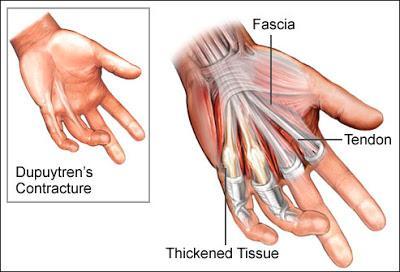
*Borrowed from webmd.com
Q: I have Dupuytren's contracture in my left hand. I am unable to place my hand flat upon the mat. The fascia in my palm underneath my ring and pinkie fingers has become knotted and tight and will not stretch out. Because of this, the alignment from my fingers to my shoulder (and maybe farther!) is thrown off when I do poses on hands and knees and at the wall. How can I practice safely for all body parts and make sure my body is well aligned.A: Baxter and Nina will answer your question together because while Baxter is the medical doctor and yoga therapist, Nina actually has had this condition for a number of years herself.
We'll begin by discussing the condition. Dupuytren’s contracture refers to a condition of the fingers and hands in which collagen is gradually deposited in the fascia just below the skin near some of the finger tendons on the palm side of the hand.
These deposits, which appear as nodules, puckering, or cords on palm, lead to gradual shortening of the fascia near the finger tendons. This in turn results in a flexed (bent) finger or two, at one of the joints, which prevents normal extension (straightening) of those fingers and a full opening of the palm. You can imagine how this would negatively affect physical activities that require five fingers that can straighten completely, including opening a jar, grasping objects, playing an instrument, typing, and doing yoga poses that require full finger extension with palms flat on the floor, such as Cat-Cow or Downward-Facing Dog poses. The most commonly affected fingers are the fourth and fifth (ring and pinkie fingers). The condition usually only affects one hand, and most typically only one finger, but there are exceptions.
Collagen, which is a normal component of different connective tissues in the body, (such as fascia, ligament, meniscus and skin) in this instance, is abnormally deposited for unknown reasons. The condition is also called Vikings disease, as those of Northern European descent are at higher risk of developing this condition as well as those who have a family history of the condition, are male, are over 50, who smoke, who are regular drink larger amounts of alcohol, or who have diabetes. Although not terribly common, it is estimated to affect somewhere between 1 and 7% of the adult population in the US and 4-6% of Caucasians worldwide.
The condition is gradually progressive over years (although at very variable rates), and there is no known cure. Symptoms can include stiffness of the affected fingers, mild sensitivity over the knots in the fascia, and sometimes pain, especially with overstretching.
In very early stages, those with Dupuytren’s contractures are encouraged to massage their palms and stretch it to help maintain and improve extension of the fingers involved, but beyond that stage, those methods have no significant impact on reversing the curl of the fingers involved.
Western medical treatment options for when the contractures begin interfering with daily activities include: non-surgical options of localized radiation treatments, injection of an enzyme into the collagen bands that helps dissolve them, or surgical techniques that cut, release, or remove the collagen cords.
Baxter was unable to find any studies on yoga and Dupuytren's contracture. However, he has several students over the years with this condition, and have learned by working with them that you can certainly modify certain poses or substitute others to continue to enjoy benefits of regular yoga practice as well as maintaining the good alignment our reader desires.
Since the contractures mean that one or more fingers on your hand cannot fully stretch out, all the poses where you have your hands palm down on the floor may be impacted. We will start off by presenting with the easiest modifications that allow you to continue to do the classic pose whenever possible, and move to other options for those with greater restrictions.
First of it, it is possible that if you have very mild bending in your finger/fingers, you can continue to do the classic version of poses with palms down without any alignment issues or pain. Having just the fingertip on the floor or wall without the rest of the finger touching it shouldn’t throw your alignment off dangerously (after all, we are all somewhat asymmetrical and many of us have one shoulder than is more flexible than the other). But you should use your proprioception and/or an outsider observe to see if you alignment is reasonably even or not in the pose.
Changing Finger Positions. Nina has noticed that if you have the problem in your pinkie finger, if you keep the pinkie and ring finger touching instead of spread apart, the bend is greatly reduced. So one thing you could try is practicing either with all the fingers together on both hands (except the thumbs) or even Mr. Spock hands (“Live Long and Prosper”) with only space between your middle and ring finger.
Props for Hands. If you get to the stage where palms down no longer feels balanced or causes pain, you might next try using a prop to support BOTH your palms and let your fingers hang off the front. Nina says that can try a folded sticky mat, which will still allow your fingertips to touch the ground, or you can use two blocks on the lowest height, which will allow all your fingers just to drape down toward the floor.
Baxter says that you might also find that specialized curved props for both your hands, such as a curved half-blocks that match the amount of flexion (bending) of the affected finger(s), helpful. However, Baxter has not had the opportunity to try this out with any of his students, so he cannot vouch for how effective this will be. And Nina is skeptical about this idea as she has tried wrapping her hands around many different curved objects, and her finger joint still continues to pop up.
Chair Poses. From there, you can move onto modifications of the poses where your hands are in a different position, such as holding onto a prop instead of having a flat palm. For example, Nina suggests that by practicing the chair versions of Downward-Facing Dog, Plank, Upward-Facing Dog, and Upward Plank poses, you can avoid the need for flat hands by wrapping your fingers around the sides of the chair. You can even do vinyasas this way.
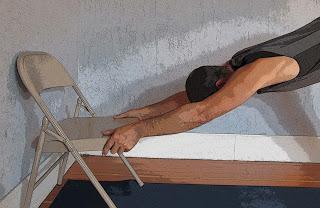
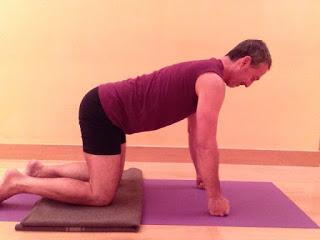
You can also use a fist for your bottom hand to a block or floor in standing poses, such as Triangle pose, which you typically do with your palm flat on the floor or a block. Of course, you can also just drape your fingers off the front of the block. See which works best for you.
Forearm Versions. For more extreme contractures (bending), you have the option of using the forearm variations of poses that normally would be on hands only. For example, you can practice Downward-Facing Dog, Plank, and Side Plank poses on your forearm instead of just your hand, which will remove most of the weight from the hand and wrist. Because there is less weight on the hand, your bent finger may not affect alignment as much. Keep in mind that these poses will work the body in different ways than the classic poses, so you may want to practice these poses for shorter periods of time at first to acclimate gradually.
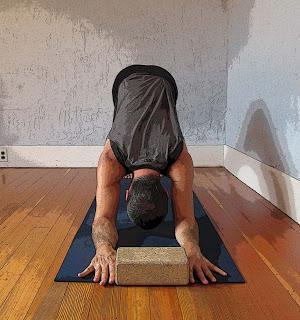
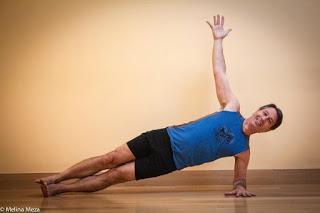
For Cat-Cow, if you want to use your forearms on the floor, you will need to support them with blocks to “raise” the floor up to meet them, otherwise, with forearms are on the floor, your spine will going to be angled downward toward the floor instead of parallel to it.
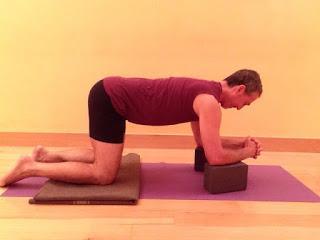
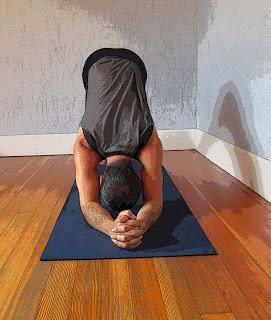
General Recommendations. For any of these modifications, in poses where you’re on two hands at the same time, be sure to use the techniques with both hands/arms so you will be able to maintain even alignment in your symmetric poses.
And for poses where your hands are on the wall, you can use these same modifications with support under your palm or using a fist or forearm instead of a flat hand. As on the floor, if you have both hands on the wall in the pose at the same time, modify both hands, not just the problem hand.
Finally, the modifications we are recommending here could also be helpful for those with other issues in the hand/wrist area, such as arthritis of the thumbs, wrist pain, carpel tunnel syndrome, and wrist tendonitis.
—Baxter and Nina
Subscribe to Yoga for Healthy Aging by Email ° Follow Yoga for Healthy Aging on Facebook ° Join this site with Google Friend Connect

